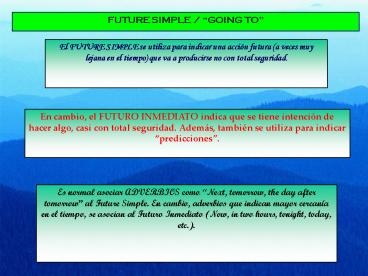Presentaci PowerPoint PPT Presentation
Title: Presentaci
1
FUTURE SIMPLE / GOING TO
El FUTURE SIMPLE se utiliza para indicar una
acción futura (a veces muy lejana en el tiempo)
que va a producirse no con total seguridad.
En cambio, el FUTURO INMEDIATO indica que se
tiene intención de hacer algo, casi con total
seguridad. Además, también se utiliza para
indicar predicciones.
Es normal asociar ADVERBIOS como Next, tomorrow,
the day after tomorrow al Future Simple. En
cambio, adverbios que indican mayor cercanía en
el tiempo, se asocian al Futuro Inmediato (Now,
in two hours, tonight, today, etc.).
2
Para formar oraciones INTERROG. en FUTURO SIMPLE,
ponemos WILL/SHALL (1ª persona del singular y 1ª
del plural) al principio de la oración, más
SUJETO y verbo en su forma de infinitivo sin to
Para formar oraciones AFIRMATIVAS en FUTURO
SIMPLE, elegimos un SUJETOWILL/SHALL (1ª persona
del singular y 1ª del plural) y un verbo en su
forma de infinitivo sin to
Para formar oraciones NEGATIVAS en FUTURO SIMPLE,
elegimos un SUJETOWONT/SHANT (1ª persona del
singular y 1ª del plural) y un verbo en su forma
de infinitivo sin to
3
EJEMPLOS. FUTURE SIMPLE
The new and big elephant will be at the show next
Friday. The new and big elephant will NOT be at
the show next Friday. The new and big elephant
WONT be at the show next Friday. We shall be at
the show next Friday. We SHANT be at the show
next Friday. WILL the new and big elephant be at
the show next Friday?. SHALL we be at the show
next Friday?. Thomasll look for a map tonight.
(contracción) Steven will is my best friend.
(INCORRECTO) Steven will studies English
(INCORRECTO)
4
Para formar oraciones INTERROG. en FUTURO
INMEDIATO, ponemos AM,IS, ARE al principio de la
pregunta Sujeto GOING TOverbo en infinitivo
sin to.
Para formar oraciones AFIRMATIVAS en FUTURO
INMEDIATO, elegimos un SUJETOAM,IS, ARE GOING
TO y un verbo en su forma de infinitivo sin to.
Para formar oraciones NEGATIVAS en FUTURO
INMEDIATO, elegimos un SUJETOAM,IS, ARENOT (o
la forma contraída) GOING TO y un verbo en su
forma de infinitivo sin to.
5
EJEMPLOS. FUTURE GOING TO.
The cats are going to run on the roofs. The cats
are NOT going to run on the roofs. The cats
areNT going to run on the roofs. The catsre
going to run on the roofs. (contracción) Are the
cats going to run on the roofs?. Arent the cats
going to run on the roofs?. Steven is going to
is my best friend. (INCORRECTO) Steven is going
to studies English (INCORRECTO)
6
RECUERDA
Los dos tiempos verbales CAMBIAN el verbo
AUXILIAR al PRINCIPIO de oración en oraciones
INTERROGATIVAS (WILL / SHALLFuture Simple), (AM,
IS, AREFuturo Inmediato).
La contracción de Ill es la misma en I will
y I shall. Es OBLIGATORIO trabajar la
oración en función de si lleva Will o Shall.
Los dos tiempos verbales COLOCAN la negación
NOT detrás del verbo AUXILIAR, en oraciones
NEGATIVAS. La forma contraída sería... (WONT /
SHANTFuture Simple), (AM NOT, ISNT,
ARENTFuturo Inmediato).
7
Adverbios como NEVER,ALWAYS, etc. Aparecerán
siempre entre el verbo auxiliar y el principal.
i.e. I will always love you She is
never going to study Japanese
Como indican una acción FUTURA, pueden ir
acompañados de ADVERBIOS, como NEXT, TONIGHT,
TOMORROW,THE DAY AFTER TOMORROW, ETC.

